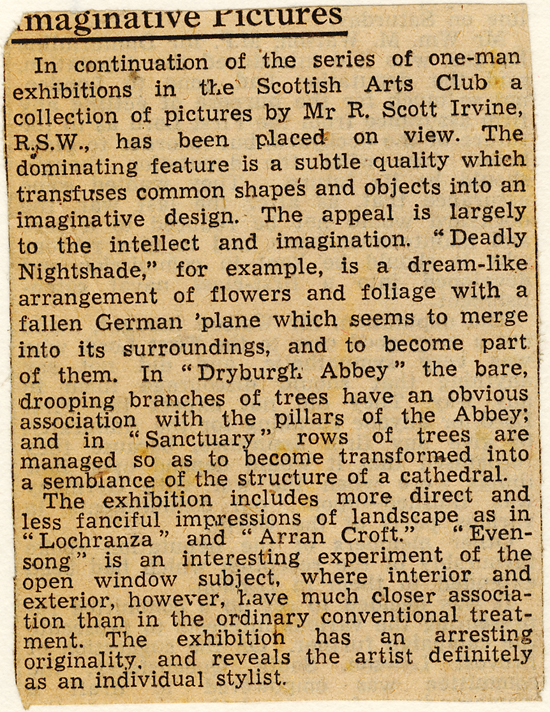
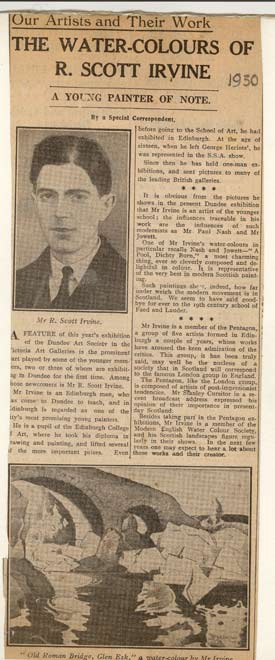 A FEATURE of this year's exhibition of the Dundee Art Society in the Victoria Art Galleries is the prominent part played by some of the younger members, two or three of whom are exhibiting in Dundee for the first time. Among those newcomers is Mr R. Scott Irvine.
A FEATURE of this year's exhibition of the Dundee Art Society in the Victoria Art Galleries is the prominent part played by some of the younger members, two or three of whom are exhibiting in Dundee for the first time. Among those newcomers is Mr R. Scott Irvine.
Mr Irvine is an Edinburgh man, who has come to Dundee to teach, and in Edinburgh is regarded as one of the city-s most promising young painters.
He is a pupil of the Edinburgh College of Art, where he took his diploma in drawing and painting, and lifted several of the more important prizes. Even before going to the School of Art, he had exhibited in Edinburgh. At the age of, sixteen, when he left George Heroin-s, he was represented in the SSA. show.
Since then he has held one-man exhibitions, and sent pictures to many of the leading British galleries.
It is obvious from the pictures he shows in the present Dundee exhibition that Mr Irvine is an artist of the younger school; the influences traceable in his work are the influences of such modernists as Mr Paul Nash and Mr Jowett.
One of Mr Irvine's water-colours in particular recalls Nash and Jowett “A Pool, Dichty Burn,“ a most charming thing, ever so cleverly composed and delightful in colour. It is representative of the very best in modern Scottish painting.
Such paintings show, indeed, how far under weigh the modern movement is in Scotland. We seem to have said goodbye for ever to the 19th century school of Faed and Lauder.
Mr Irvine is a member of the Pentagon, a group of. five artists formed in. Edinburgh a couple of years ago, whose works have aroused the, keen admiration of the critics. This group, it has been truly said, may well be the nucleus of a society that in Scotland will correspond to, the famous London group in England.
The Pentagon, like the London group, is composed of artists of post-impresionist tendencies. Mr Stanley Crustier in a recent broadcast address expressed his opinion of their importance in presentday Scotland.
Besides taking part in the Pentagon exhibitions, Mr Irvine is a member of the Modern English Water Colour Society, and his Scottish landscapes figure regularly in their shows. In the next few years one may expect to hear a lot about these works and their creator. -
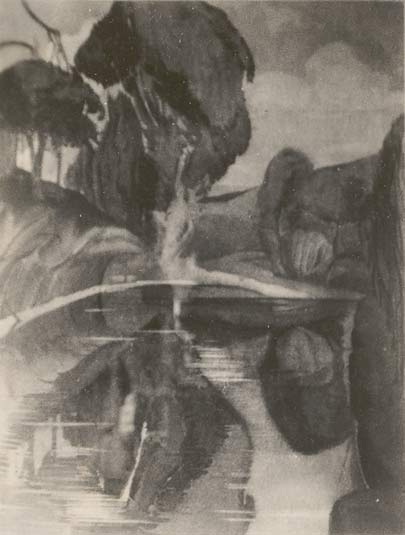 Some of the water-colours of Mr. R. Scott Irvine, a newcomer to the exhibition at Dundee's Municipal Art Galleries, show the draughtmanship and rare handling of colour 'A Pool, Dichty Burn' is a delightful little picture.
Some of the water-colours of Mr. R. Scott Irvine, a newcomer to the exhibition at Dundee's Municipal Art Galleries, show the draughtmanship and rare handling of colour 'A Pool, Dichty Burn' is a delightful little picture.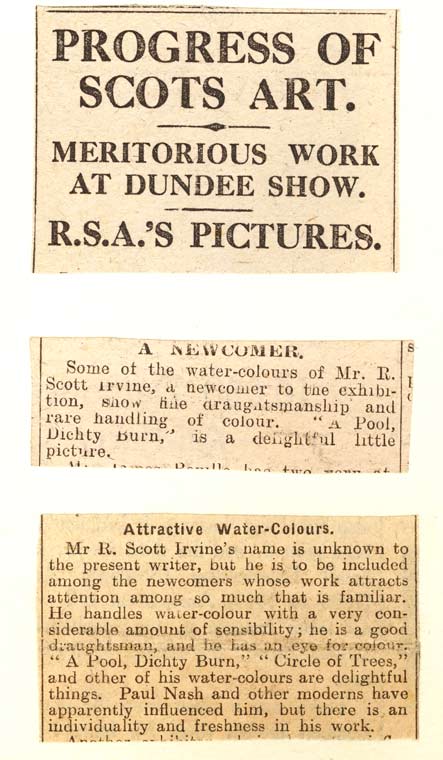 Edinburgh Evening News
Edinburgh Evening News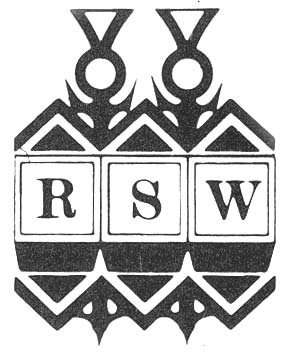
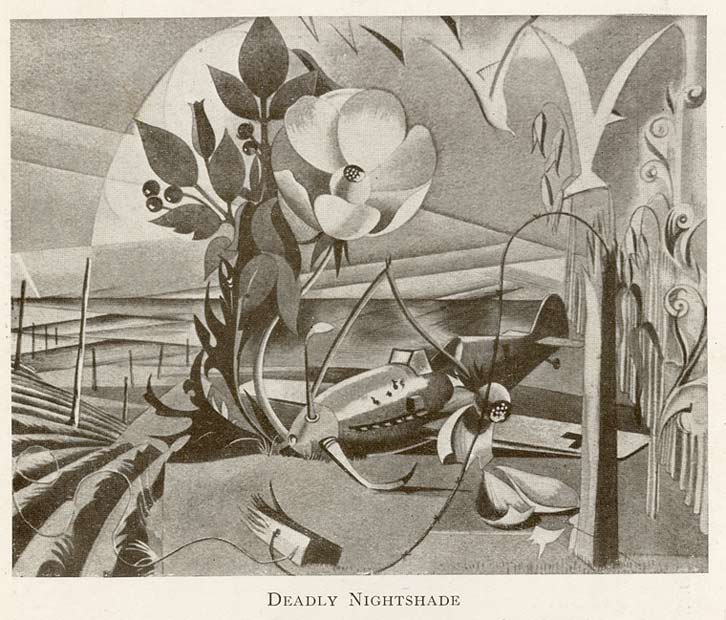
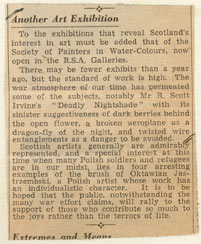 There may be fewer exhibits than a year ago, but the standard of work is high. The war atmosphere of our time has permeated some of the subjects, notably Mr R. Scott Irvine's "Deadly Nightshade" with its sinister suggestiveness of dark berries behind the open flower, a broken aeroplane as a dragon-fly of the night, and twisted wire entanglements as a danger to be avoided.
There may be fewer exhibits than a year ago, but the standard of work is high. The war atmosphere of our time has permeated some of the subjects, notably Mr R. Scott Irvine's "Deadly Nightshade" with its sinister suggestiveness of dark berries behind the open flower, a broken aeroplane as a dragon-fly of the night, and twisted wire entanglements as a danger to be avoided.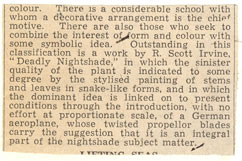 There is a considerable school with whom a decorative arrangement is the chief motive. There are also those who seek to combine the interest of form and colour with some symbolic idea. Outstanding in this classification is a work by R. Scott Irvine, “Deadly Nightshade,” in which the sinister quality of the plant is indicated to some degree by the stylised painting of stems and leaves in snake-like forms, and in which the dominant idea is linked on to present conditions through the introduction, with no effort at proportionate scale, of a German I aeroplane, whose twisted propellor blades carry the suggestion that it is an integral part of the nightshade subject matter.
There is a considerable school with whom a decorative arrangement is the chief motive. There are also those who seek to combine the interest of form and colour with some symbolic idea. Outstanding in this classification is a work by R. Scott Irvine, “Deadly Nightshade,” in which the sinister quality of the plant is indicated to some degree by the stylised painting of stems and leaves in snake-like forms, and in which the dominant idea is linked on to present conditions through the introduction, with no effort at proportionate scale, of a German I aeroplane, whose twisted propellor blades carry the suggestion that it is an integral part of the nightshade subject matter.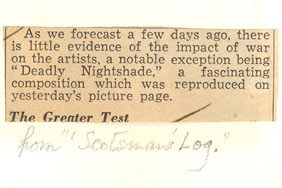
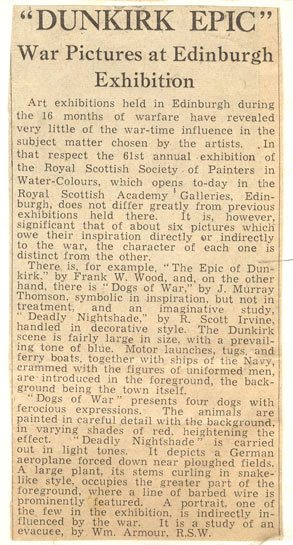 Art exhibitions held in Edinburgh during the 16 months of warfare have revealed very little of the war-time influence in the subject matter chosen by the artists. In that respect the 61st annual exhibition of the Royal Scottish Society of Painters in water-colours, which opens to-day in the Royal Scottish Academy Galleries, Edinburgh, does not differ greatly from previous exhibitions held there. It is, however, significant that of about six pictures which owe their inspiration directly or indirectly to the war, the character of each one is distinct from the other.
Art exhibitions held in Edinburgh during the 16 months of warfare have revealed very little of the war-time influence in the subject matter chosen by the artists. In that respect the 61st annual exhibition of the Royal Scottish Society of Painters in water-colours, which opens to-day in the Royal Scottish Academy Galleries, Edinburgh, does not differ greatly from previous exhibitions held there. It is, however, significant that of about six pictures which owe their inspiration directly or indirectly to the war, the character of each one is distinct from the other.
 A FEATURE of this year's exhibition of the Dundee Art Society in the Victoria Art Galleries is the prominent part played by some of the younger members, two or three of whom are exhibiting in Dundee for the first time. Among those newcomers is Mr R. Scott Irvine.
A FEATURE of this year's exhibition of the Dundee Art Society in the Victoria Art Galleries is the prominent part played by some of the younger members, two or three of whom are exhibiting in Dundee for the first time. Among those newcomers is Mr R. Scott Irvine.